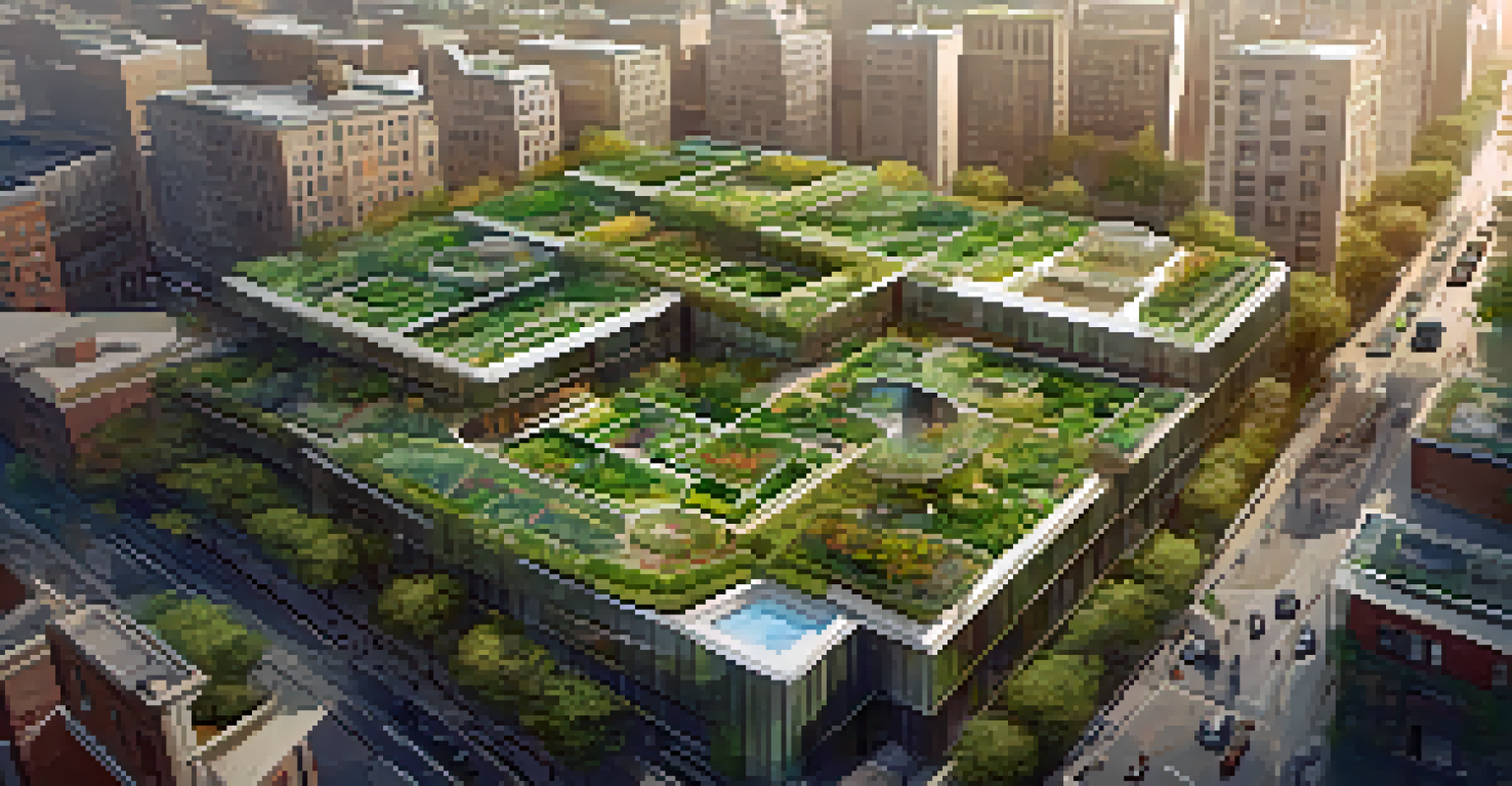Plants as Natural Air Filters in Urban Ecosystems Explained

Understanding Urban Air Pollution and Its Impact
Urban air pollution is a significant challenge faced by cities worldwide. It is caused by various factors, including vehicle emissions, industrial activities, and even household products. This pollution not only affects the environment but also poses serious health risks to urban populations, leading to respiratory issues and other ailments.
The greatest threat to our planet is the belief that someone else will save it.
As cities grow, the need for effective air quality solutions becomes increasingly urgent. The World Health Organization reports that approximately 90% of people breathe polluted air, making it a pressing global issue. This alarming statistic highlights the necessity to explore all available options to combat urban air pollution.
In this context, plants emerge as natural allies in the fight against air pollution. Their remarkable ability to absorb harmful pollutants and release oxygen makes them crucial players in enhancing air quality. Let's delve into how these green warriors function and their role in urban ecosystems.
How Plants Filter Air: The Science Behind It
Plants naturally filter air through a process known as phytoremediation, where they absorb pollutants through their leaves and roots. During photosynthesis, they take in carbon dioxide and release oxygen, simultaneously cleaning the air. This process not only benefits plants but also contributes to healthier urban environments.

Certain plant species are particularly effective at filtering specific pollutants. For instance, spider plants and peace lilies are known to remove common indoor toxins such as formaldehyde and benzene. By strategically placing these plants in urban settings, we can significantly enhance air quality and promote a healthier lifestyle.
Plants Improve Urban Air Quality
Plants play a crucial role in filtering pollutants and enhancing air quality in urban environments.
Moreover, plants can capture particulate matter, such as dust and smoke, on their leaves. This natural filtration system plays a vital role in reducing airborne pollutants, showcasing how integrating greenery into urban landscapes can lead to cleaner air and improved public health.
The Role of Urban Green Spaces in Air Quality
Urban green spaces, like parks and gardens, serve as vital lungs for cities. These areas not only provide recreational opportunities but also act as essential buffers against pollution. The greenery in these spaces helps mitigate the heat island effect, which can exacerbate air quality issues in urban areas.
Nature does not hurry, yet everything is accomplished.
By increasing the number of trees, shrubs, and plants in cities, we can significantly reduce air pollution levels. Research shows that urban areas with more green spaces experience lower concentrations of pollutants, leading to better air quality. This correlation underlines the need for city planners to prioritize green infrastructure.
Moreover, green spaces foster biodiversity, supporting various species and creating balanced ecosystems. This interconnectedness benefits both the environment and the residents, promoting a sense of community and well-being in urban areas.
Selecting the Right Plants for Air Filtration
Not all plants are created equal when it comes to air filtration. Some species are more effective at removing pollutants than others. When choosing plants for urban environments, it's essential to consider their specific filtration capabilities, growth requirements, and adaptability to local conditions.
For instance, ferns and rubber plants are great choices for indoor spaces due to their ability to filter out harmful chemicals. In outdoor settings, trees like oaks and maples can provide shade and significantly improve air quality. Researching native plant species can also enhance biodiversity and ensure successful growth.
Green Spaces Reduce Pollution Levels
Increasing urban greenery, such as parks and gardens, significantly lowers air pollution concentrations.
Incorporating a variety of plants into urban settings maximizes air purification benefits. By creating diverse green spaces, we can harness the full potential of plants as natural air filters and promote healthier urban ecosystems.
Community Involvement in Urban Greening Initiatives
Community involvement is crucial for the success of urban greening initiatives. Engaging local residents in planting and maintaining green spaces fosters a sense of ownership and responsibility. This involvement can lead to a stronger community bond and a shared commitment to improving local air quality.
Organizing community events, such as tree planting days or gardening workshops, can encourage participation and educate residents about the benefits of plants as air filters. These events provide opportunities for people to learn about different plant species and their air quality benefits while also beautifying their neighborhoods.
Collaborating with local schools and organizations can further enhance these efforts. By integrating environmental education into curricula and community programs, we can inspire future generations to value and protect their urban ecosystems.
The Future of Urban Air Quality and Green Solutions
As urban populations continue to grow, addressing air quality challenges will remain a priority. Innovative solutions that integrate plants into urban planning can lead to sustainable improvements in air quality. Urban forestry, green roofs, and vertical gardens are just a few examples of how we can incorporate nature into city landscapes.
Cities around the world are already implementing green infrastructure to combat air pollution. For instance, Singapore is known for its extensive greenery integrated into its architecture and urban spaces, showcasing how effective these strategies can be. Such initiatives inspire other cities to adopt similar practices for cleaner air.
Community Involvement is Key
Engaging local communities in greening initiatives fosters a sense of ownership and contributes to better air quality.
By prioritizing the incorporation of plants into urban environments, we can build healthier, more sustainable cities. The future of urban air quality lies in recognizing the invaluable role that plants play as natural air filters and embracing green solutions.
Conclusion: Embracing Plants for Cleaner Urban Air
In conclusion, plants are not just decorative elements in our cities; they are vital allies in improving air quality. Their natural ability to filter pollutants and provide oxygen makes them essential components of urban ecosystems. By understanding and leveraging these benefits, we can create healthier living environments for ourselves and future generations.
As we move forward, it is crucial to advocate for the integration of green spaces and effective plant species into urban planning. Every tree planted and every garden cultivated contributes to a cleaner, more breathable atmosphere. Let's embrace the power of plants and work collectively toward healthier cities.

Ultimately, the health of our urban ecosystems relies on our commitment to nurturing the plants that contribute to cleaner air. By fostering a culture of appreciation for greenery, we can enhance our urban landscapes and promote a sustainable future.